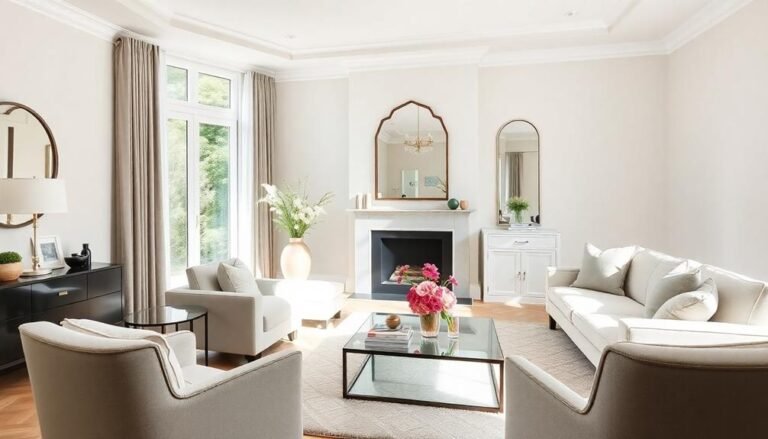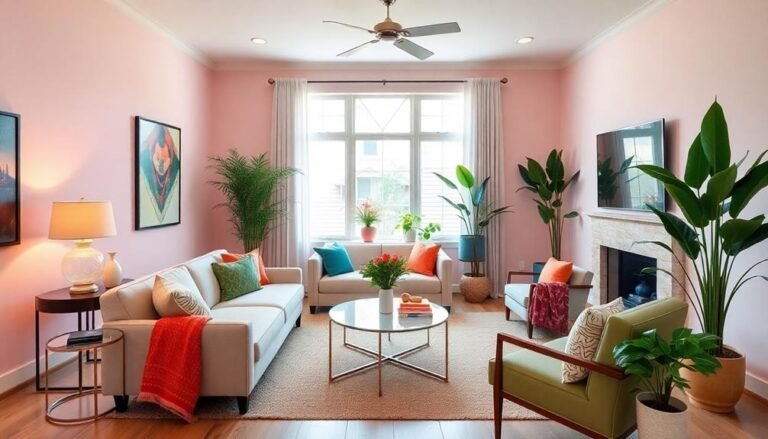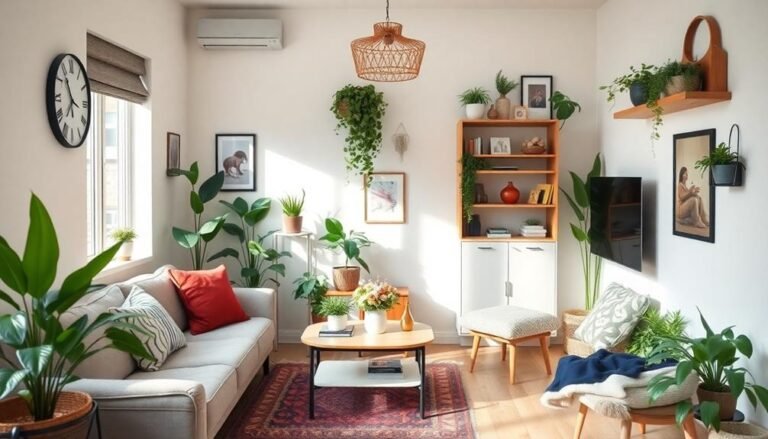Staging a home with textures and patterns is essential for appealing to buyers. You'll want to understand how different materials influence mood; for example, a plush velvet sofa invites warmth, while sleek leather suggests sophistication. Layering textures like rugs, throw pillows, and wall treatments adds depth. Incorporating purposeful patterns, such as bold stripes for height or delicate florals for softness, can enhance the desired atmosphere. Balancing bold elements with subtle decor creates harmony. Finally, selecting colors that resonate emotionally can unify the look. Explore these strategies further to master the art of staging and capture potential buyers' interest effectively.
Understanding Textures and Patterns
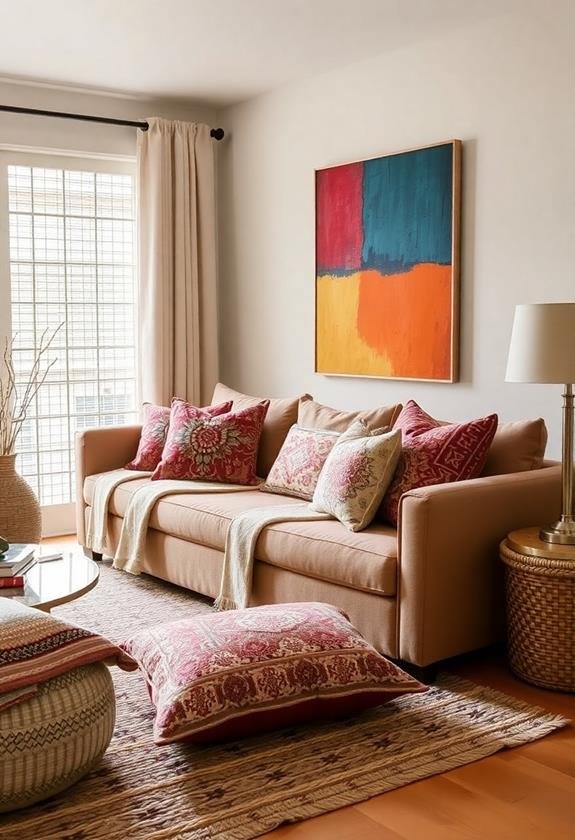
Textures and patterns play an essential role in staging, instantly transforming a space and influencing its mood. When you consider how different materials and designs interact, you'll see how they can evoke feelings of warmth, energy, or calm. For instance, a plush velvet sofa adds softness, inviting potential buyers to envision themselves relaxing in that space. Conversely, sleek leather can create a modern, sophisticated vibe that might appeal to a different audience. Incorporating eco-friendly materials, such as organic textiles, can also resonate with buyers looking for sustainability in their home choices, reflecting current trends in sustainability.
Patterns, too, can greatly impact a room's atmosphere. A bold geometric print can energize a space, while subtle stripes can create a sense of order and sophistication. Think about how you can mix various textures, like pairing smooth wood with a chunky knit throw, to create visual interest without overwhelming the senses.
When staging, remember that less is often more. You want to accentuate the space, not distract from it. Aim for a cohesive look by selecting a few key textures and patterns that complement each other. By understanding these elements, you can enhance the appeal of your space, making it more inviting for potential buyers while allowing them to imagine their future in it.
Choosing the Right Color Palette
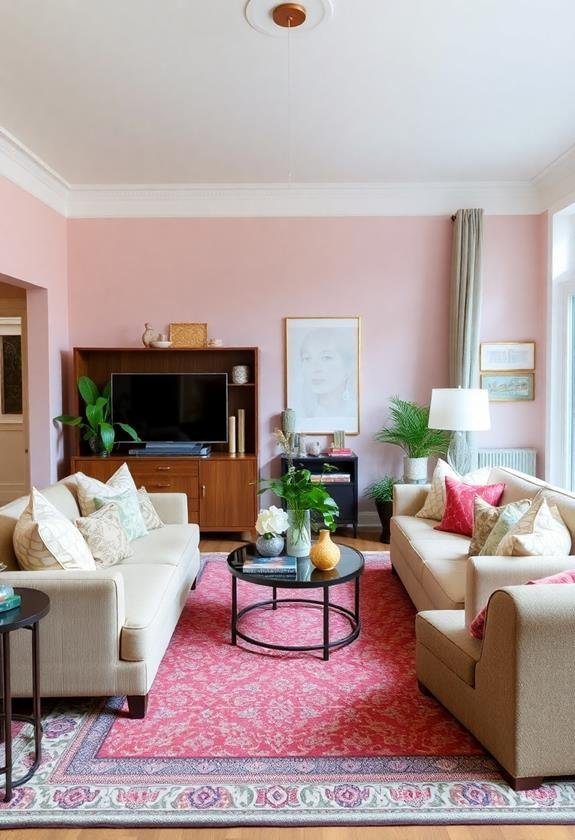
When staging a home, selecting the right color palette can greatly enhance the overall feel of the space. Start by considering the emotions you want to evoke in potential buyers. Soft, neutral tones like beige or light gray create a calming atmosphere, making rooms feel larger and more inviting. Incorporating trending home decor items for 2024 can also help in complementing the chosen colors. On the other hand, bolder colors, such as navy or emerald green, can add sophistication and a touch of drama, but use them sparingly to avoid overwhelming the space.
Think about the home's architecture and the natural light available. Rooms that receive plenty of sunlight can handle darker colors, while those with limited light benefit from lighter hues to keep them bright and airy. Additionally, consider creating a cohesive flow throughout the home by using a consistent color scheme in different areas.
You might also incorporate accent colors through accessories, such as throw pillows or artwork. This approach adds personality without committing to a permanent change. Ultimately, the right color palette not only highlights the home's features but also helps buyers envision themselves living there, making it an essential aspect of effective home staging.
Layering Textures for Depth
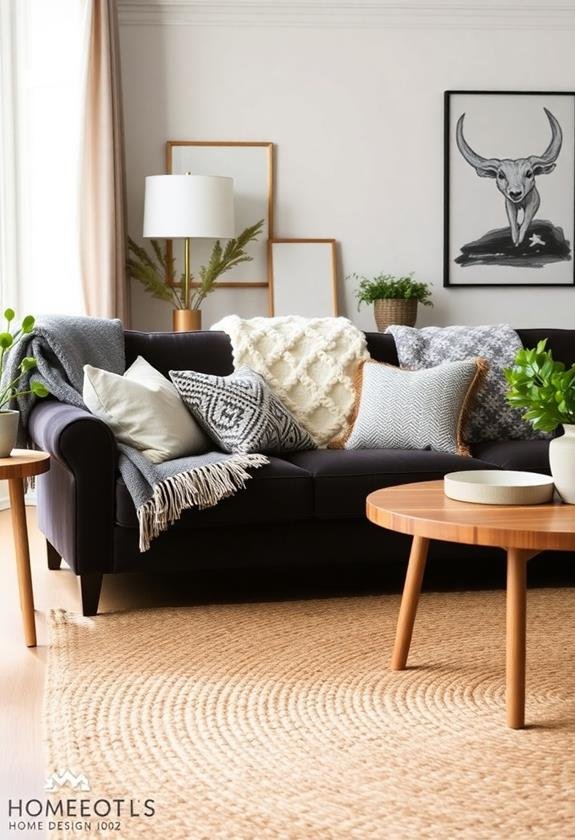
Incorporating three to four layers of texture in a room can create a rich, inviting atmosphere that captivates buyers. Start with a base layer, like a plush area rug, which adds warmth underfoot and anchors the space. Opt for a stylish shag rug, such as the Livabliss Hapsburg Moroccan Shag Rug, which offers durability and a modern aesthetic. Next, think about your furniture choices; a soft sofa in a neutral tone can serve as a perfect backdrop for further textures.
Add a variety of throw pillows in different materials, such as velvet, linen, and cotton, to introduce depth and interest. Consider draping a knitted throw across the back of the sofa; this not only adds visual appeal but also invites a sense of coziness.
Don't forget about wall textures! Incorporating elements like a textured wallpaper or wood paneling can enhance the room's character. You might even hang a few textured art pieces that echo the other layers you've chosen.
Incorporating Patterns With Purpose
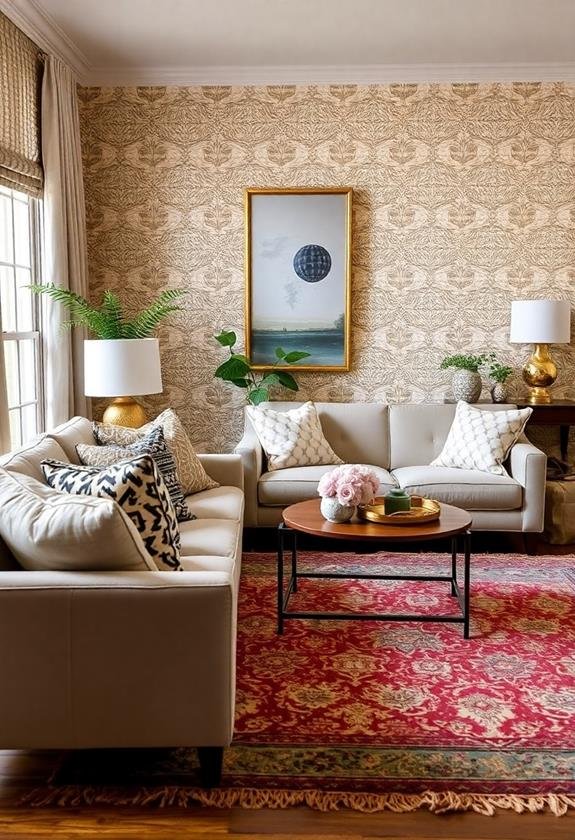
Layering textures sets a solid foundation for your design, but adding patterns can elevate the overall aesthetic even further. When incorporating patterns, think about the purpose they serve in your space. For instance, bold stripes can create an illusion of height in a room, while delicate florals can introduce a touch of softness and warmth. Choosing the right pattern not only adds visual interest but also helps convey the mood you want potential buyers to feel.
Consider the scale of your patterns, as larger designs can make a statement, while smaller prints tend to blend more seamlessly. For example, if you have a neutral sofa, adding a patterned throw pillow can draw the eye without overwhelming the space. Additionally, mixing patterns can be effective when done thoughtfully. You might pair a geometric print with a subtle floral, ensuring they share a common color palette to maintain cohesion.
Ultimately, patterns should complement your overall design vision. By thoughtfully incorporating patterns with purpose, you invite buyers to imagine themselves in your beautifully staged home, enhancing their connection and emotional response to the space.
Balancing Bold and Subtle Elements
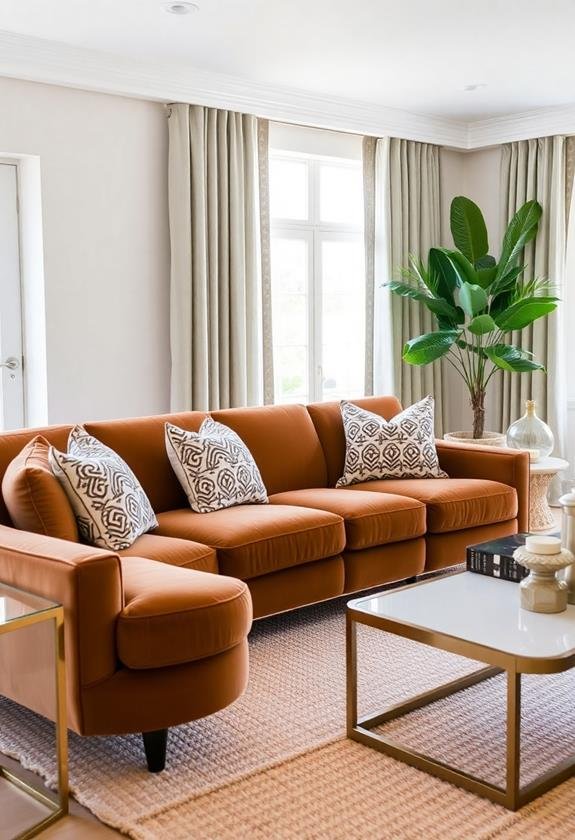
Finding the right balance between bold and subtle elements can transform your staging from ordinary to extraordinary. Bold colors, striking artwork, or unique furniture pieces can grab attention, but if overdone, they might overwhelm potential buyers. On the flip side, subtle elements—like soft neutrals and delicate textures—create a calming atmosphere that invites people in without distraction.
To achieve the ideal mix, start by selecting one or two bold focal points in each room. This could be an eye-catching piece of art or a vibrant throw pillow that adds character. Next, surround these bold elements with softer, more understated decor. For instance, pair a bright accent chair with a neutral sofa and gentle lighting to guarantee the space feels balanced.
As you stage, keep in mind the overall vibe you want to convey. Consider how each item interacts with others, guaranteeing they complement rather than compete. By thoughtfully balancing bold and subtle elements, you not only enhance the visual appeal of your space but also create an environment that feels both inviting and harmonious—perfect for attracting prospective buyers.
Textiles That Transform Spaces
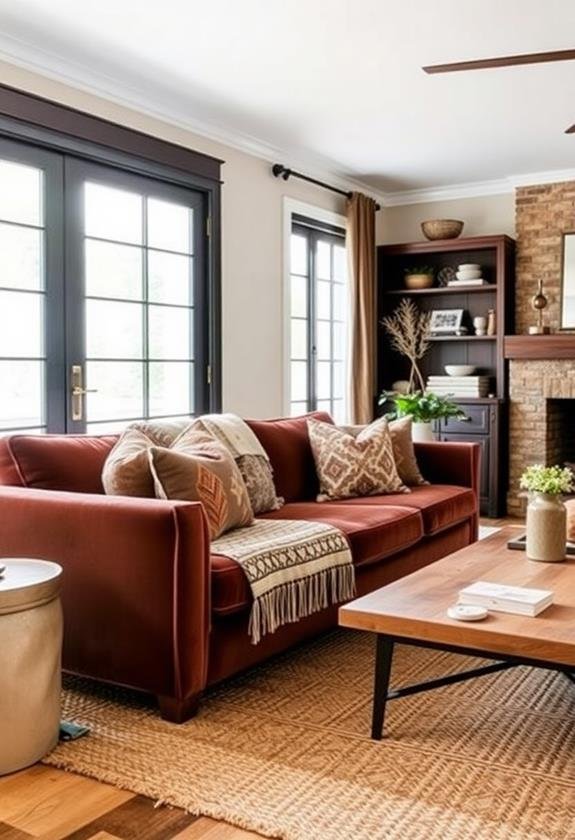
Textures and patterns play an essential role in staging, as they can completely transform the feel of a space. By incorporating various textiles, you can create an inviting atmosphere that resonates with potential buyers. Think about using soft throws, decorative pillows, and vibrant area rugs to add warmth and personality to a room. These elements can soften harsh lines and create a cozy environment that encourages buyers to envision themselves living there.
When selecting textiles, consider the overall theme of your space. For instance, if you're staging a modern home, opt for sleek fabrics with geometric patterns; they can enhance your aesthetic without overwhelming the senses. Conversely, in a more traditional setting, rich textures like velvet or intricate woven patterns can evoke a sense of comfort and nostalgia.
Don't underestimate the power of layering textiles. By combining various fabrics, you can add depth and interest to your staging. For example, a plush rug over hardwood floors can bring warmth, while a mix of patterned cushions on a neutral sofa can create visual intrigue. Ultimately, the right textiles not only enhance the appeal of your space but also leave a lasting impression on potential buyers.
Highlighting Architectural Features
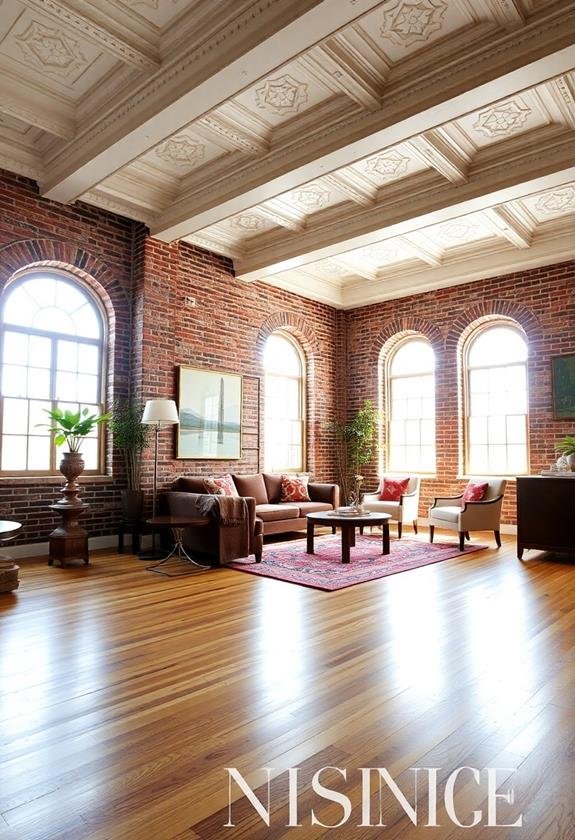
Highlighting architectural features can greatly enhance the appeal of a staged home. When potential buyers walk through, they should immediately notice the unique elements that make your home special. Start by drawing attention to crown moldings, exposed beams, or elegant archways. These characteristics not only add character but also create a sense of space and elegance.
To emphasize these features, consider using lighting strategically. Soft, warm lights can illuminate a beautiful fireplace or highlight intricate detailing on a staircase. You can also arrange your furniture to create sightlines that guide buyers' eyes to these features. For instance, placing a stylish chair near a window with beautiful trim allows natural light to enhance the architectural details.
Don't forget the power of contrast; using lighter colors against darker woodwork can make those features pop. Additionally, if you have any built-ins, keep them tidy and staged with tasteful decor to showcase their functionality and charm. By thoughtfully highlighting these architectural elements, you'll create an inviting atmosphere that appeals to buyers, inviting them to envision their lives within your home's unique framework.
Creating a Cohesive Look
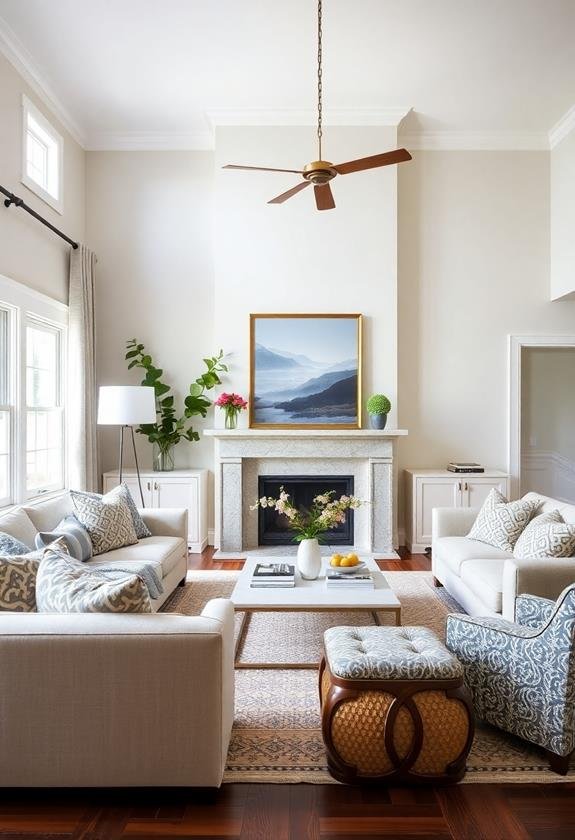
Achieving a cohesive look in your staged home creates a seamless flow that captivates potential buyers. To accomplish this, choose a color palette that unifies your spaces. Stick to two or three main colors, incorporating different shades and tones to add depth without overwhelming the eye. For instance, if you opt for blues and grays, consider using a soft navy for larger pieces and lighter shades for accents.
Next, think about the textures and patterns you'll use. Mixing textures—like smooth glass, soft fabrics, and rustic wood—can add interest while still feeling connected. For patterns, select those that complement each other; for example, a striped rug can pair well with a floral throw, provided you keep the colors consistent.
Additionally, maintain a consistent style throughout your home. Whether you choose modern, traditional, or eclectic, guarantee that every room reflects that theme. This doesn't mean every piece must match perfectly, but rather that they should resonate with one another. By thoughtfully combining colors, textures, and styles, you'll create a cohesive look that draws buyers in, helping them envision themselves living in the space.
Final Touches for Staging Success
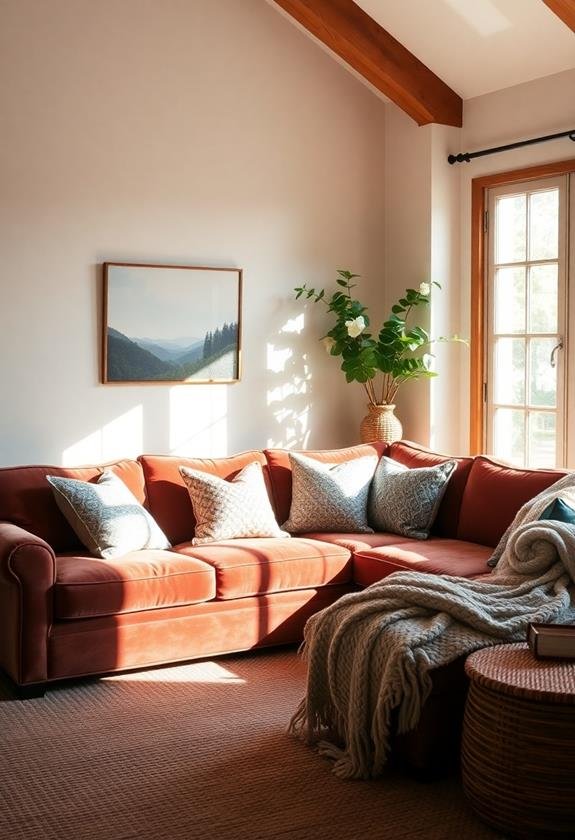
While you've put in the effort to create a cohesive look, the final touches can truly elevate your staging game and make a lasting impression on potential buyers. These small details can transform a good space into a memorable one, enticing buyers to envision themselves living there. Here are four essential final touches to take into account:
- Personalized Accents: Incorporate items like books, art, or decorative bowls that reflect the room's style. These elements add warmth and character.
- Fresh Flowers: A simple vase of fresh flowers can brighten up a room and create an inviting atmosphere. Choose seasonal blooms for an extra touch of charm.
- Scent Matters: Think about using subtle air fresheners or candles. A pleasant aroma can enhance the overall experience and evoke positive emotions.
- Lighting Adjustments: Make certain all lights are functional and think about adding soft lamps or dimmers. The right lighting creates a cozy ambiance that can make a space feel more inviting.
Frequently Asked Questions
How Do I Choose Textures That Resonate With Potential Buyers?
When choosing textures that resonate with potential buyers, start by considering their preferences. Think about soft fabrics that evoke comfort, like plush throw pillows or cozy blankets. You might also explore sleek surfaces that suggest modernity, such as glass or metal accents. Pay attention to colors, as they can enhance the textures you select. Finally, remember to create a balanced mix; too much variety can overwhelm, while harmony invites buyers to envision themselves in the space.
What Common Mistakes Should I Avoid When Using Patterns?
When using patterns, avoid these common mistakes. First, don't overdo it; too many patterns can clash and overwhelm a space. Stick to a cohesive color palette to create harmony. Also, be cautious with scale; large patterns can dominate a room, while tiny ones may get lost. Finally, guarantee patterns complement each other—mixing geometric with organic can work, but it often requires balance. Keep these tips in mind, and your space will feel inviting and polished.
How Can I Determine the Right Amount of Layering?
To determine the right amount of layering, think about a well-dressed individual from the '80s, balancing style and comfort. Start with a base layer, then add textures or patterns that complement each other without overwhelming the space. Aim for a mix of light and dark tones, ensuring they harmonize. Test different combinations, stepping back frequently to assess the overall effect. Ultimately, you want a cohesive look that feels inviting and visually intriguing.
Should I Consider Seasonal Trends in My Staging?
Yes, you should definitely consider seasonal trends in your staging. By incorporating seasonal elements, like cozy blankets in fall or bright flowers in spring, you create a warm, inviting atmosphere that resonates with buyers. This approach not only enhances the visual appeal but also helps potential buyers imagine themselves in the space during different times of the year. Pay attention to current styles and colors, as they can greatly impact buyer perception and interest.
How Can I Effectively Showcase My Home's Unique Features With Textures?
To effectively showcase your home's unique features with textures, start by incorporating various materials like wood, metal, and fabric. For instance, a soft, plush rug can contrast beautifully with a sleek coffee table. Utilize pillows and throws in different fabrics to add depth and warmth to your space. Highlight architectural details, like exposed beams or unique moldings, with complementary textures that draw the eye, creating a cohesive, inviting atmosphere that resonates with potential buyers.


